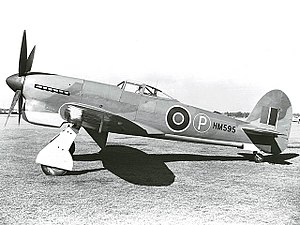Hawker Tempest
| Tempest | |
|---|---|
 |
|
| Tempest V prototype HM595 with early "car door" cockpit structure and small tail units. | |
| Role | Fighter |
| Manufacturer | Hawker Aircraft Limited |
| Designer | Sydney Camm |
| First flight | 2 September 1942 |
| Introduction | January 1944 |
| Status | Retired |
| Primary users |
Royal Air Force Indian Air Force Royal New Zealand Air Force Pakistan Air Force |
| Number built | 1,702 |
| Developed from | Hawker Typhoon |
| Developed into | Hawker Sea Fury |
The Hawker Tempest was a British fighter aircraft primarily used by the Royal Air Force (RAF) in the Second World War. The Tempest was an improved derivative of the Hawker Typhoon, the type originally being known as the Typhoon II, which was intended to address the Typhoon's unexpected fall-off of performance at high altitude by replacing its wing with a thinner laminar flow design. Having diverged considerably from the Typhoon, it was chosen to rename the aircraft Tempest. The Tempest emerged as one of the most powerful fighters of the World War II and was the fastest propeller-driven aircraft of the war at low altitude.
Upon entering service in 1944, the Tempest was used as a low-level interceptor, particularly against the V-1 flying bomb threat, and as a ground attack platform, in which it supported major events such as Operation Market Garden. Later, it successfully targeted the rail infrastructure in Germany and Luftwaffe aircraft on the ground, as well as countering such attacks by German fighters. The Tempest was effective in the low-level interception role, including against newly developed jet-propelled aircraft such as the Messerschmitt Me 262. The further developed Tempest Mk.II, which had several improvements including being tropicalised, was intended to see combat against Japan in South-East Asia as part of the Commonwealth Tiger Force, did not enter service until after the end of hostilities.
During development of the earlier Hawker Typhoon, the design team, under the leadership of Sydney Camm, had already planned out a series of design improvements; these improvements cumulated in the Hawker P. 1012, otherwise known as the Typhoon II. Although the Typhoon was generally considered to be a good design, Camm and his design team were disappointed with the performance of its wing, which had proved to be too thick in its cross section, and thus created airflow problems which inhibited flight performance, especially at higher altitudes and speeds. The Typhoon's wing, which used a NACA 4 digit series wing section, had a maximum thickness to chord ratio of 19.5 per cent (root) to 12 per cent (tip), in comparison to the Supermarine Spitfire's 13.2 per cent tapering to 6 per cent at the tip, the thinner design deliberately chosen to reduce drag. In addition, there had been other issues experienced with the Typhoon, such as engine unreliability, insufficient structural integrity, and the inability to perform high altitude interception duties.
...
Wikipedia
